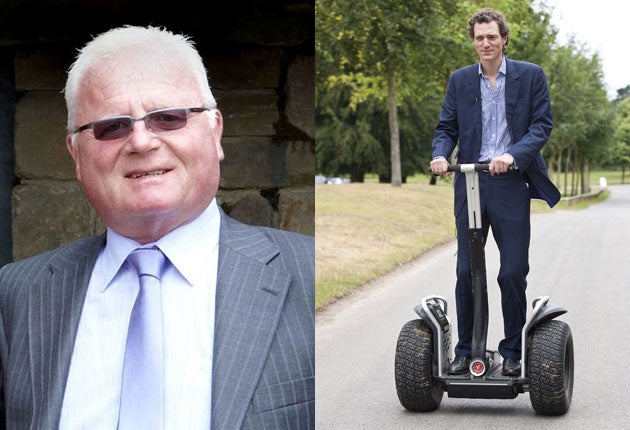Segway tycoon dies in cliff fall while riding scooter

The Segway was hailed before its launch as a green transport solution of the future. One such believer in the emission-free scooter-cum-skateboard was a former Yorkshire miner turned multimillionaire philanthropist called Jimi Heselden, who last year bought the American firm which invented the self-righting two-wheeler. But in what appears to have been a freak accident, Mr Heselden has been found dead after apparently plunging 30ft over the side of a cliff while riding one of the machines he hoped would revolutionise the way we travel.
It is believed Mr Heselden was driving an off-road version of the £5,000 upright scooter on a heavily rutted path through the idyllic landscape near his home when tragedy struck. The 62-year-old's body was discovered in the River Wharfe by a walker on Sunday on the edge of his country estate at Boston Spa near Wetherby, West Yorkshire. His Segway was found near by.
A spokesman for West Yorkshire Police said the entrepreneur was pronounced dead at the scene.
"The incident is not believed to be suspicious and the coroner has been informed," he said.
Tributes were paid to the local businessman who used his redundancy payout following the 1980s miners' strike to develop the Concertainer – an adaptation of a medieval defensive system using wire baskets of earth and water which replaced sandbags as a means of protecting troops. The anti-blast device rapidly became one of Britain's most successful defence exports and helped its inventor earn a fortune of £166m and a place in the Sunday Times Rich List.
His purchase of Segway in December last year surprised observers in the UK who felt the device had more than a touch of Sir Clive Sinclair's doomed electric vehicle the C5 about it. Its intuitive controls and gyroscopic balancing systems may have appealed to technology fans but the Segway, which can be difficult to operate, initially proved a hard sell to the public and was for long dismissed as little more than a rich geek's toy. Despite attracting celebrity drivers such as Dame Helen Mirren and Dick Cheney, the Segway remains banned on British pavements and roads where it is deemed unsafe by the Department of Transport, although it can be used on private land.
Yet Mr Heselden became convinced of the potential of the inventor Dean Kamen's commuting device, launched in 1999, after commissioning research in the United States, where it is legal in many cities.
The scooter, which bears more than a passing resemblance to a golf trolley, has witnessed a surge in popularity in recent years among parking enforcement officers and university campus police, countering the negative publicity generated by George W Bush, who fell off a Segway in 2003. It is now estimated that there are 80,000 Segways in use worldwide.
In Britain, the Segway won the support of the then Tory transport spokesman Robert Goodwill as well as the Liberal Democrats' Lembit Opik. Fans of the machine are keenly awaiting the results of a pending test case. Philip Coates, 51, was charged this year under the 1865 Highways Act for riding his 12mph Segway on the pavement on his five-mile trip to work in Barnsley, South Yorkshire, and is due to return to court in November.
Earlier this month, Mr Heselden signed over a £10m cheque for the Leeds Community Foundation which channels money into disadvantaged areas in his home city.
The gift brought his lifetime donations to £23m. He had chosen to base his company, Hesco Bastion Ltd, close to his old childhood home in one of Leeds' most deprived communities.
He said recently: "Life turned out pretty well for me, but I still work in the same area where I grew up and every day I see people who for whatever reason are down on their luck."
Fatal creations
Marie Curie
The Polish-born physicist's pioneering work led to the discovery of polonium and radium. Her research earned her the Nobel Prize first in 1903 and again eight years later but she died in 1934 from leukaemia resulting from prolonged exposure to high-energy materials during her research.
Jim Fixx
In 1984 – seven years after publishing the best-selling get-fit-quick guide The Complete Book of Running – the formerly overweight journalist credited with launching the jogging craze was found dead by the side of the road near his home in New England after collapsing during a run. He was 52 and had a history of heart disease.
Franz Reichelt
The French tailor's determination to publicise his wearable parachute for aviators saw him leap from the Eiffel Tower in 1912. Having ignored friends' insistence to use a dummy, Reichelt's canopy failed to deploy and he crashed to his death. The tragedy was captured on camera by newspaper and newsreel cameramen.
Otto Lilienthal
A 19th century German pioneer of human flight and inheritor of the dream of Icarus, Lilienthal's discoveries in the field of gliding paved the way for the future success of the Wright brothers. In 1896 however he plunged 60ft to the earth during a test flight suffering a broken spine. He died the following day insisting his sacrifice had been worth it.
Henry Winstanley
The treacherous Eddystone rocks off Plymouth were feared by generations of sailors, so the creation of an illuminated wooden structure was welcomed by mariners. Winstanley had wished to be inside the lighthouse during the "greatest storm there ever was". But during terrible weather in 1703, the building collapsed and he was lost at sea.
Join our commenting forum
Join thought-provoking conversations, follow other Independent readers and see their replies
Comments
Bookmark popover
Removed from bookmarks